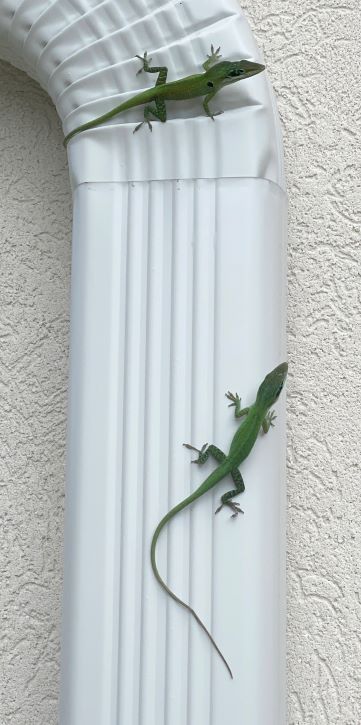
By Pat-Foster-Turley Ph.D.
April 21. 2022
It doesn’t take long for new north Florida residents to discover the lizards around us. There are a number of lizards in our yards, like glass lizards (that resemble snakes) and skinks (often with a blue tail) but more than likely the first lizard you encounter will be an anole. These small lizards are a common element in north Florida yards, porches, and surrounding vegetation. There are two species of anoles that occupy our land. One species, the green anole, has been around for years. The other, the brown (or Cuban) anoles arrived only in the past few decades, causing concern among many green anole lovers for their tendency to displace the green natives.
Green anoles are charming little critters that resemble chameleons in their ability to change color at will. Sometimes they look green, as their name describes, but other times they can turn various shades of brown to blend in with their environment or to show an altered emotional state. Locals in these parts have been calling them chameleons for years, even though the true chameleons are only found in the Old World (i.e. Africa, Asia and parts of Europe) but not here in the United States, except for a few escaped pets. (If you want to see real chameleons head to Yulee to visit Sam’s Flying Frog Ranch pet store on Highway 17.)
But if you just admire the green anoles in your own backyard you will see what I mean about their color changes. Sometimes you can watch one moving across a brown tree trunk, brown itself, then unto some foliage, and turning green to match this background. Spring is breeding time for these anoles, and they change color, too, in the height of the mating process. It’s fun to watch, even if it does seem a bit voyeuristic.

But then came the Cuban anoles, which are always brown. They can change a bit in their brownish tones but never turn green. These little lizards are more “prehistoric” in their appearance and often have stripes and markings that define individuals. This makes it fun to get to know particular ones in your environs, since they stick to well-defined territories. Twenty some years ago when we first started seeing Cuban anoles (which moved up here from south Florida and the Caribbean) the green anoles seemed to have disappeared. The theory was that the Cuban anoles were more dominant and displaced the shyer green anoles from their rightful place.

Ah, but nature has a way of correcting itself if given the chance. This year we are seeing lots of both species of anoles once again in our back yard. The green anoles have begun inhabiting the higher branches of shrubs, while the Cuban anoles stick closer to the ground, making room for one and all.
Our cat Dumela (named after a greeting in Botswana where we once lived) is a great fan of anoles too. For the most part her anole-watching is through our windows, where she can harmlessly paw at them hoping for a reaction. Occasionally an anole of one type or another manages to slip into our house and the fun really begins for Dumela. With the renowned patience of a cat, she will spend many minutes fixated in front of our bookcase, where an anole has taken refuge. We try to catch the poor lizard and get it back outdoors where it belongs, but often this takes a few days. The poor critters finally crawl out of hiding, from hunger and thirst, and we easily scoop up their depleted skinny forms to put them outside in a plant that has insects and water drops to sustain it. It doesn’t daunt Dumela a bit. She is always on the lookout for more of them.
Some people I know have taken anole watching to a new degree. They purchase mealworms from a pet store and make a routine out of feeding them. Anoles learn quickly to accept this food source and will come out of hiding when their human brings them these offerings. It’s like having pets without all the responsibility of cage cleaning—perfect!
I hope you will enjoy the anoles in your back yard like we do. Here in north Florida, It’s another accessible form of nature watching that we all can partake in right at home. And there’s nothing wrong with that!
Pat Foster-Turley, PhD is a zoologist on Amelia Island. She welcomes your nature questions and observations. [email protected]

The little guys are every where! Thanks, for the description of where they are from how they are dividing the territory between them. This will make it more interesting to look for them and enjoy their antics.
I am intrigued by these little creatures. They are such fun to watch. Thank you for the information.
I love watching the lizards cavort in my backyard and sometimes in my house.